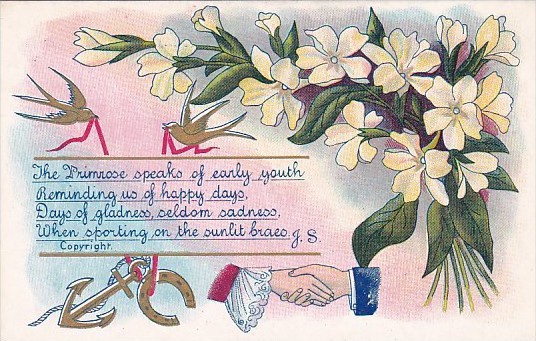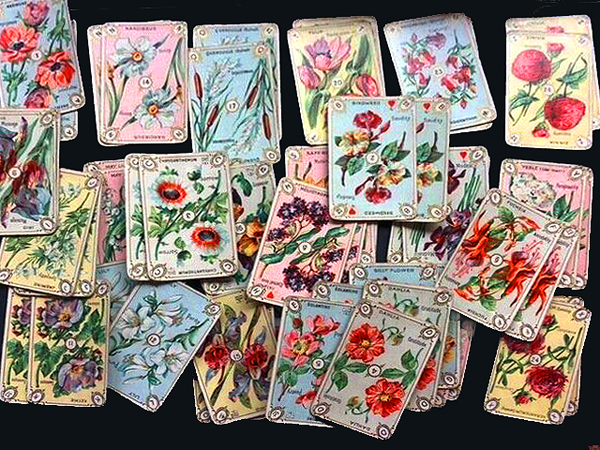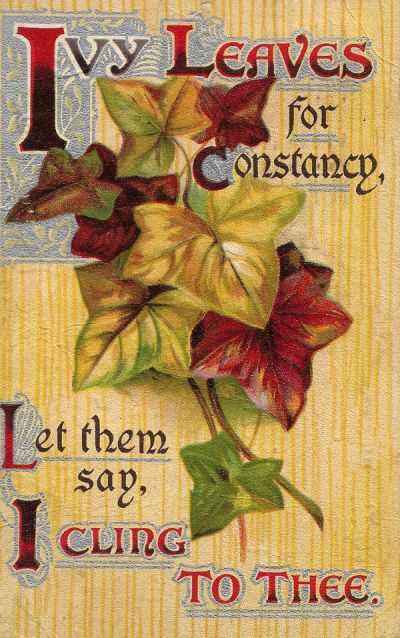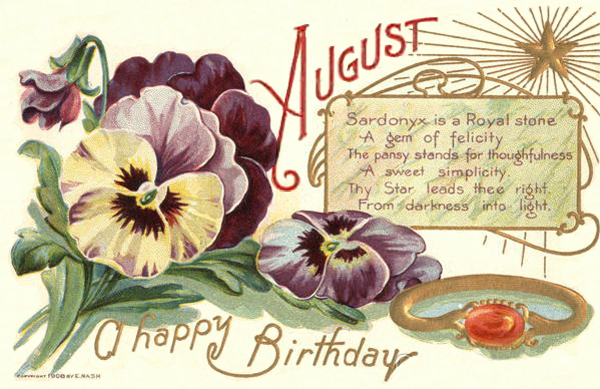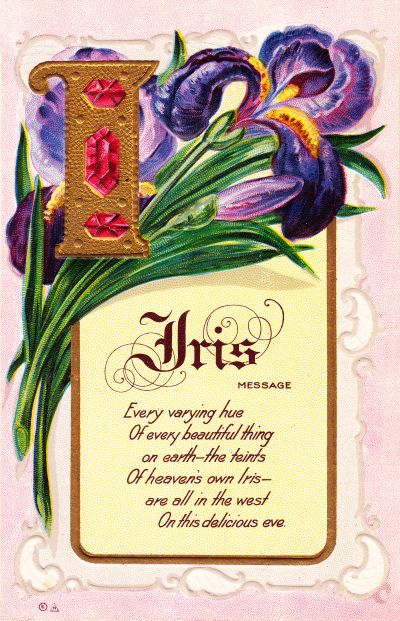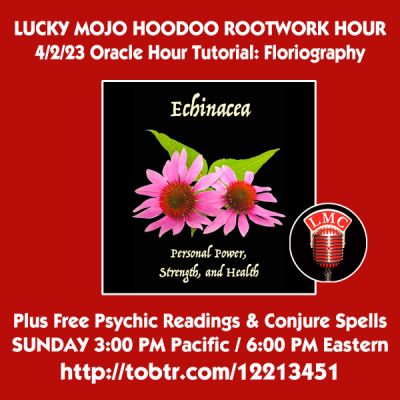Category:Floriography
My Patreon supporters paid for this page and had access to it one full year before the public did.
- Patreon Release Date: September 21st, 2021
- Public Release Date: September 21st, 2022.
Please tell your friends that they can subscribe to my Patreon stream for $2.00 per week:
Patrons; To discuss this and other Patreon pages with me, join my private Patreon Forum:
Support Your Wate and Fate
A Message in a Bouquet
Floriography or The Language of Flowers is a metaphysical symbol-system and a secret form of communication in which flowers, twigs, leaves, and other botanical items are used to communicate ideas.
- Flowers may be listed in correspondence with planets, the signs of the zodiac, and spiritual entities such as goddesses, gods, and saints, in the same way that stones and minerals are, in order to facilitate magical spell-casting, divination by omens, and identification of spiritual entities in imagery or as offerings to them on altars.
- Flowers may be assigned specific meanings in a coded language ("The Language of Flowers" or "Floriography") so that secret messages can be exchanged between people in the form of gift bouquets or potted plants, or in allusive poetry, conversation, or fiction, without observers or outsiders being aware of the message transmission method or the message itself.
In the first usage, Floriography has been around for centuries, as a way of marking omens, assuring the proper offerings for spiritual beings, and gathering ingredients for casting spells.
The latter form -- the coded language -- arose during the mid 19th century in France and soon spread to England and North America. Due to the era of its first appearance, during the reign of Queen Victoria of England, it is often referred to as "The Victorian Language of Flowers,"
Botanomancy and Floriography
The earliest form of Floriography was Botanomancy. This term comes from the Greek word botanikos, meaning "of herbs" and the suffix -mancy, which is translated to "divination by means of" -- so Botanomancy literally means "divination by means of herbs."
In Classical Greek and Roman Botanomancy, the diviner wrote the sitter's name and question on a branch or twig of Verbena, Heather, Myrtle, Tamarind, Fig, and any other medicinal tree, shrub, or flower that was dedicated to Apollo, the Greek and Roman god who presided over divination. Apollo was given the surname "Myricoeus," which comes from the Latin word Myrica, meaning Heather, and also can relate to the plants we call Bayberry, Candleberry, or Wax-Myrtle.
The exact manner of Botanomantic divination was never completely described in Classical times, and no written "rule sets" for interpreting outcomes survive, but it is understood by scholars that the plant material, when burned, produced flames and fragrant incense smoke, and left remnants behind in the form of charred branches and ash. This indicates that at least three systems of interpretation could have been employed: pyromancy or fire reading, capnomany or smoke reading, and tephramancy or divination from charcoal and ashes. The reading would have been interpreted for the sitter orally by noting both the physical and psychic signs revealed.
In a more general sense, and in modern terms, Botanomancy can refer to any system of divination in which plants are consulted. For example, it can relate to the Norse custom of going out for a walk at the New Year and checking in on how the plants and trees are overwintering, to get a forecast for the coming year.
Botanomancy can also refer to Floriography, or the Language of Flowers and Leaves -- either flowers received in a bouquet or as a potted plant, or flowers encountered in a walk around the neighborhood or through the name of person one meets.
Floriography came to popularity during the mid 19th century. Here you can see a deck of Floriographic playing cards, called "The Language of Flowers" that dates back to the late Victorian or early Edwardian era. The 52-card deck consists of 26 pairs of illustrated floral cards, with their names and symbolic meanings printed on them. There is one pair of cards for each letter of the English alphabet. It is a simple card-matching game, suitable for children and families -- and it also teaches divination by flowers.
We have constructed our own extensive floriographic oracle at this site. It is called The Floral Oracle by Catherine and Nagasiva Yronwode.
Floral Symbolism
The ascription of symbolic significance to plants is as ancient as the use of plants in food and medicine. The magical meanings of roots, seeds, leaves, and flowers can be found everywhere on Earth. In some cases, the medical, culinary, or psychotropic use is predominant and lends its import to the plant; in other cases, the appearance or scent, especially of the flowers, plays the strongest role in the doctrine of signatures, and the meaning of the plant in magic is determined by aesthetics. This is particularly true of flowers, and an entire system of communication, called floriography or the language of flowers, has grown up around the use of flowers as messengers of unspoken meaning.
It is common in metaphysical work to overlay several correspondence systems -- astrological, mineralogical, botanical, zoological, chromatic, mythological, and religious -- so flowers often form one piece of the symbol set that accords with a given planet, zodiacal sign, day the the week, deity, stone, or metal. For this reason, floral ascriptions are often found in astrologically-based lists of months and birthstones or zodiacal signs and birthstones. To a certain extent, linkages between flowers and the zodiac or secular calendar are based on bloom-time for the flowers, but colour and form play a part as well.
Floral Languages
Floriography entered the wider world of magical popular culture during the mid 19th century, and the French were the first to both catalogue it and expand upon it, adding many exotic plants that would not be found as natives in Europe, but which were grown as garden subjects, potted greenhouse plants, or cut flowers to be given as bouquets. English books soon followed, and floriography became somewhat of a mania among the middle and late Victorian eras in England and North America. Dozens of books on the topic were published, many with lovely chromolithographic plates.
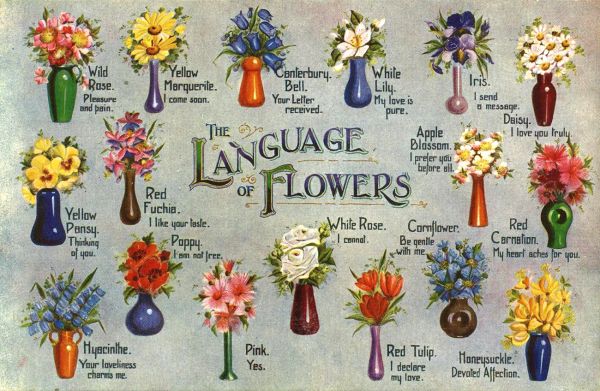
The idea was that by giving someone a bunch of flowers you could convey a coded message which could be decoded by the recipient, merely by consulting a floriographic book. Thus a gift of potted Pansies meant "Pensive Thoughts of You," while a bouquet of Lilies betokened "Purity" or non-sexual love. Red Roses told of "passionate love," but Yellow Roses spoke of "envy." And not only flowers were included in this floral language: Ivy meant "I Cling to You," and a branch of Pine conveyed "steadfastness" and "longevity."
Of course, when the postcard craze of 1907 to 1915 hit, the fine chromolithographic publishers of Germany, England, and the United States rushed to fill the desire for floriographic cards. Such postcards were usually printed and published in sets, ranging from as few as 6 to as many as 80 cards in a set.
Floriography Combined with Other Symbolisms
Instances of flowers alone being used for divination or as message-bearers are numerous in books and on cards, but during the postcard craze, almost as common as the "pure" Floriography card sets, were sets in which Floriography was combined with gemstones and the signs of the zodiac on astrological birthday and birthstone postcards.
One example of the layering of divination or symbol systems is found in in the lovely series of Sentiments of the Months by Raphael Tuck and Sons, in which a dozen flowers are selected to correlate with Astrology. This form of linkage derives from Classical, Medieval, Renaissance, and early Modern tables of correspondences in which herbs, roots, seeds, and flowers were associated with the planetary rulers of the weekdays and the twelve signs of the zodiac, which in turn hold sway over various body parts, and thus could suggest the selection of appropriate plants for medico-magical remedies.
Floriography Today
Floriography is with us still and remains popular among those who work with nature and the botanical world in their spirituality and magic. It is a deep subject with a long history, which i will continue to address here at Your Wate and Fate.
And it is worth noting that there is also a Language of Vegetables, which we will explore at a later date.
Finally, because many of the vintage postcards at this site that correlate months of the year with flowers also contain corresponding gemstones and the twelve signs of the zodiac signs, you may also find them double- or triple-listed in the categories of Birthstones and Astrology.
catherine yronwode
curator, historian, and docent
Your Wate and Fate
Special thanks to my dear husband and creative partner nagasiva yronwode for illustrations, scans, and clean-ups.
Lucky Mojo Podcasts on Floriograhy and Botanomancy
Check out these Lucky Mojo Curio Co. free audio-video podcasts on Floriography and Botanomancy:
FLORIOGRAPHY, with ConjureMan, Nagasiva, and Catherine Yronwode, is a Tutorial on Floriography, the Language of Flowers and the Meaning or Sybolism of Plants, plus free readings, free spells, and conjure consultations. Tune in online to listen to Floriography with Catherine Yronwode and ConjureMan
BOTANOMANCY, with catherine yronwode, ConjureMan, and Papa Gee is a Tutorial on Botanomancy or How to Use Plants in Fortune-Telling, and provides free readings, free spells, and conjure consultations. Tune in online to listen to Botanomancy with catherine yronwode, ConjureMan, and Papa Gee
These programs are brought to you by: The LMC Radio Network
Pages in category "Floriography"
The following 7 pages are in this category, out of 7 total.


